Chatbot Testing: The Key to Flawless User Experience
Home » Chatbot Testing: The Key to Flawless User Experience
By 2026, AI chatbots are expected to handle over 85% of all customer interactions. With AI technology making chatbots capable of handling a wide variety of queries at a moment’s notice, they are rapidly becoming the driving force behind a complete transformation in how businesses manage support and sales.
But while chatbots offer many advantages for almost any business, they also present new challenges in making sure the chatbots actually live up to customer expectations and perform according to their instructions. That’s where chatbot testing comes in.
So, how do you test chatbot performance? Let’s deep dive into how to test a chatbot in this guide.
What is chatbot testing?
Chatbot testing is a process of evaluating a bot’s performance, accuracy, and ability to respond to queries. It’s a crucial part of ensuring that your chatbot can understand and respond to questions and requests while also meeting your business goals.
Companies that invest in chatbot technology see up to a 40% boost in customer satisfaction and a 30% drop in service costs. But achieving those types of numbers requires a diligent process for ensuring consistency and accuracy in various situations.
With the help of AI bot testing, you can catch errors before they go live, preventing negative brand experiences. They also make it easier to improve answer relevance and accuracy, aligning them with your business goals while also improving customer satisfaction.

Not having a reliable process for testing chatbots has a high business cost in terms of lost leads and frustrated customers. And with 73% of Americans saying they wouldn’t use a chatbot after a single bad experience, that’s a price that’s too high to pay.
Sometimes, a single mistake can even be covered by the press around the world and cause irreversible reputational damage. Air Canada’s chatbot gave incorrect refund advice, resulting in a denied claim and a legal ruling that held the airline accountable, and the mistake was most likely a result of insufficient chatbot testing.
Key types of chatbot testing
There are nine key chatbot test types you should be aware of to ensure they work properly on your website. You may not need all of them, depending on your chatbot’s use case and business goals, but it’s a good idea to gain a general understanding of how they work.
Onboarding testing
First impressions can shape the entire relationship between a customer and a business. But if your chatbot greets visitors with an irrelevant, inappropriate, or inaccurate message, they may bounce before even having a chance to learn more about what you have to offer.
Onboarding testing helps ensure that the chatbot’s welcome messages are aligned with your business goals and will make a positive first impression on website visitors.
You can test various conversation starters directly in the NoForm dashboard, seeing how the chatbot handles the queries based on the customer intent.
It allows you to quickly test what would happen if users clicked different conversation starters, such as “Would you like to schedule an appointment?”, or “Do you offer a money back guarantee?” for risk reversal, seeing whether the chatbot can accurately convey your key value proposition and drive early engagement.
You can also simulate various edge cases, such as users typing in incomplete information or using emojis.
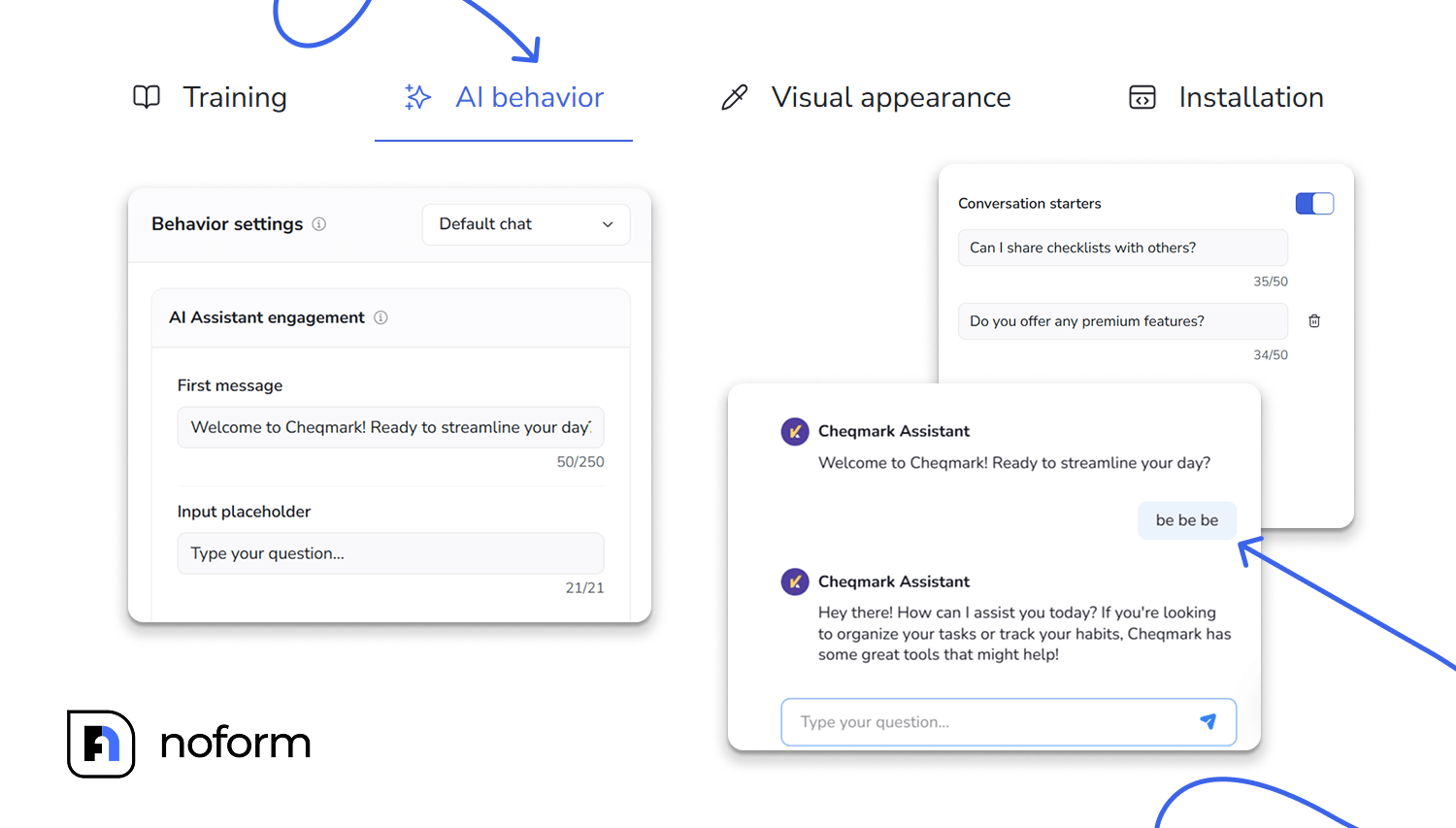
Conversation testing
A broken conversation flow can confuse users and cause them to drop off. For example, if a user starts a return process but then switches to shipping, your chatbot should be able to seamlessly switch between the topics without restarting the chat or confusing the visitor.
With the help of conversation testing, you can ensure that your chatbot stays aligned with the information it needs to provide, based on the data available in the Help Center articles or custom instructions.
To test the chatbot, simulate real-world interactions using frequently asked questions from your Help Center. Try to mimic real-world user behavior – interrupt flows to test recovery, enter off-topic queries, and use unusual grammar or language to check whether the chatbot stays on track.
NoForm streamlines the process, allowing you to test conversations in the dashboard, push the chatbot to its limits in various scenarios, and ensure it’s able to read the users and politely redirect the conversion, always responding respectfully.
Language testing (NLU)
The ability to understand user language is critical for providing accurate responses in various situations. A huge part of that comes down to Natural Language Understanding (NLU), which enables modern chatbots to understand context and better read the true meaning behind answers.
For example, when someone says “can I get a quote for roofing services?”, the chatbot needs to be able to recognize that it’s an actionable task that requires immediate attention and not just a general query.
To perform language testing, input both simple and multi-layered queries, assess the chatbot’s ability to handle multiple questions, evaluate entity extraction for names, dates, or locations, and ensure that the chatbot can handle misspellings, slang, or ambiguous phrasing.
For example, you could test the chatbot’s ability to recognize misspellings or unusual language (“wen is my stuff gonna arrive?”) or nuanced questions (“What if I want to change my order but also keep the discount”?”). NoForm AI is trained to manage a variety of similar cases, handling context clues and typos with ease, which makes training and testing a much simpler and faster process.
Multilingual testing
For any business operating globally, offering multilingual support is a must. But for chatbots, handling multiple languages at once can be a challenge, so it’s crucial to carefully test to ensure consistency when operating in different situations.
Imagine a French-speaking customer trying to update their order, but the chatbot fails to switch languages and responds with a generic English error message. This would very likely confuse and frustrate the customer, costing a sale in the process.
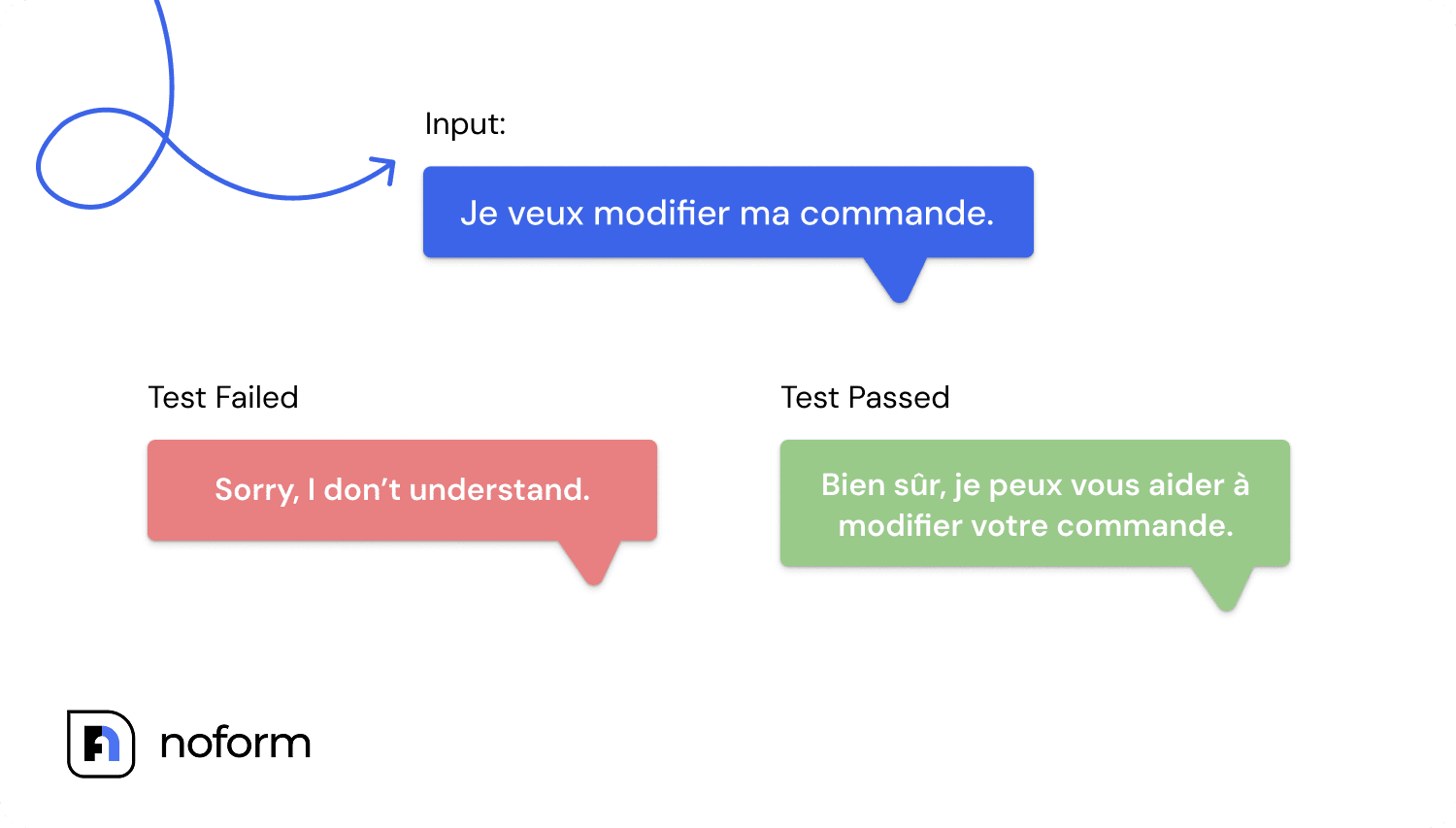
To perform multilingual testing, make sure to push the limits of the chatbot by switching languages in the middle of the conversation. Try to evaluate whether they are able to adhere to a localized tone and terminology and also capture subtle cultural nuances. NoForm AI supports multilingual interactions and can seamlessly switch between languages based on user preferences.
Guidance and navigation testing
One of the key jobs a chatbot has is to direct users to the relevant pages at the right time, based on their needs. If this process isn’t working as it should, that will inevitably lead to missed opportunities to capture leads and drive sales.
For example, a user asking for help with their invoice should be sent to the correct billing page, not a generic contact form or a help article.
With the help of guidance and navigation testing, you can ensure that the chatbot guides users to the right actions and the right places, even in unusual situations. You should click through links and check their accuracy, test call-to-action timing, and see if everything works smoothly on both desktop and mobile environments.
Performance and scalability testing
Consistent chatbot performance is important in all situations, but it’s especially crucial when you’re receiving more traffic or are rapidly scaling your business. That’s when the ability to quickly handle queries and not run into technical issues can be the difference between rapid growth and a permanently damaged situation.
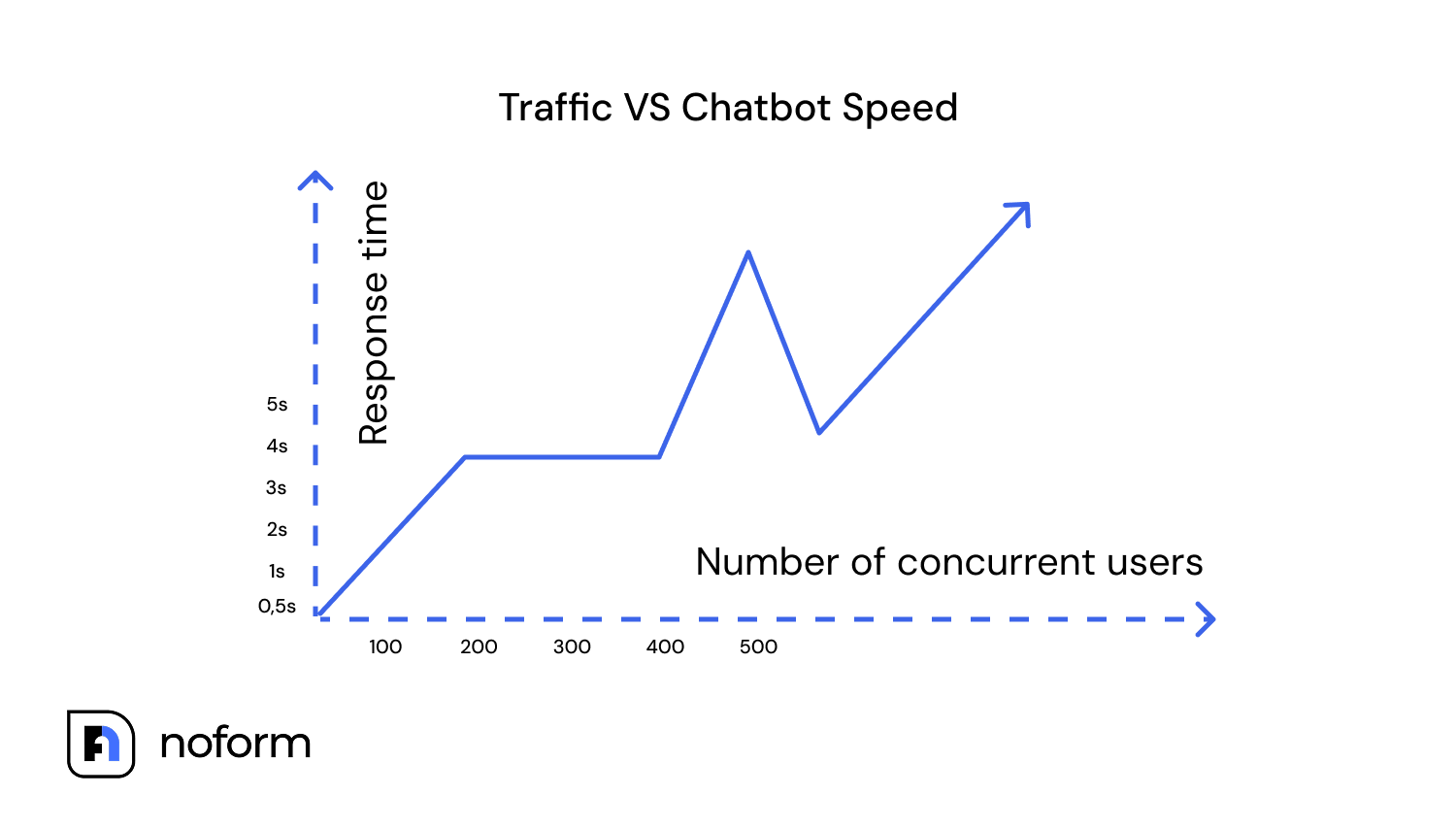
At the same time, the chatbot needs to consistently respond quickly, providing stable performance based on its training. For example, if you decide to run a flash sale that results in a surge of traffic, you want to be sure that the chatbot not only stays online but also maintains the accuracy of responses.
When doing chatbot quality assurance for performance and stability, focus on evaluating response time and stability under traffic spikes. Simulate peak traffic using chatbot testing tools and look for system lag, errors, and degradation in performance over time. Noform AI’s architecture is designed for scalability, making it a reliable choice during sudden spikes in user activity.
Sentiment analysis testing
Understanding sentiment in user emotions helps chatbots tailor responses and accurately determine when to escalate to human agents. Otherwise, a chatbot may end up completely misreading the situation and creating frustration or anger that forever loses that customer.
For example, when a customer is angry because they’ve been overcharged on an order, the chatbot should recognize the frustration in the tone and acknowledge it, offering to escalate the issue and resolve it as quickly as possible.
Testing for sentiment analysis can seem tricky, but it comes down to going through various scenarios and using different emotional tones to see how AI changes its responses.
For example, if a user sends a frustrated message (“This is ridiculous!” or “Why is this so hard?”) or uses sarcasm or praise in ways that may be tougher to interpret (“Oh great, another bug. Yay!”), the chatbot must be able to discern the difference and respond appropriately every time.
Functionality testing
A chatbot needs to deliver consistent performance, no matter the device or browser a customer might be using. Otherwise, you may remain oblivious that a significant portion of your customers are receiving subpar assistance, costing your business sales opportunities in the process.
A common example of poor functionality is a bot that works well on one browser, such as Chrome but runs into issues on Safari. Or, they may run into issues for mobile users.
To ensure the chatbot works properly across platforms, run tests on various devices, operating systems, and browsers. You should also verify integrations with external tools like CRMs for scheduling appointments or other tasks.

Security testing
One of the worst chatbot scenarios to run into is them sharing or improperly handling sensitive customer or company information. This can severely damage trust your company worked hard to build, cause reputational damage, and even result in serious legal issues that can cause a company’s downfall.
To ensure user data protection and compliance with regulations, you should perform thorough tests looking for potential vulnerabilities or unauthorized access opportunities. You should refer to compliance requirements in your country and make sure that the chatbot adheres to compliance and safe data handling.
It’s also important to check responses to sensitive input values, making sure the chatbot understands how to handle these situations and does not leak or misuse the information in any way. For example, if the user shares their credit card number during a conversation (“My credit card number is…”), you must ensure that the bot never stores or echoes this information in the chat.
NoForm AI complies with GDPR and CCPA requirements, ensuring that your customer data remains secure while also being receptive to training that helps avoid breaches of security.
Best practices for effective chatbot testing
When figuring out how to test chatbot performance, it’s a good idea to follow a few best practices that help ensure consistency and get ahead of potential issues.
Define clear objectives
To effectively test your AI-powered chatbot, you first need to define what success looks like based on your business goals. While you will perform similar tests regardless, what you look for in your evaluations will often differ based on whether you want to boost lead generation, reduce custom inquiry volume, or improve customer engagement and drive more sales.
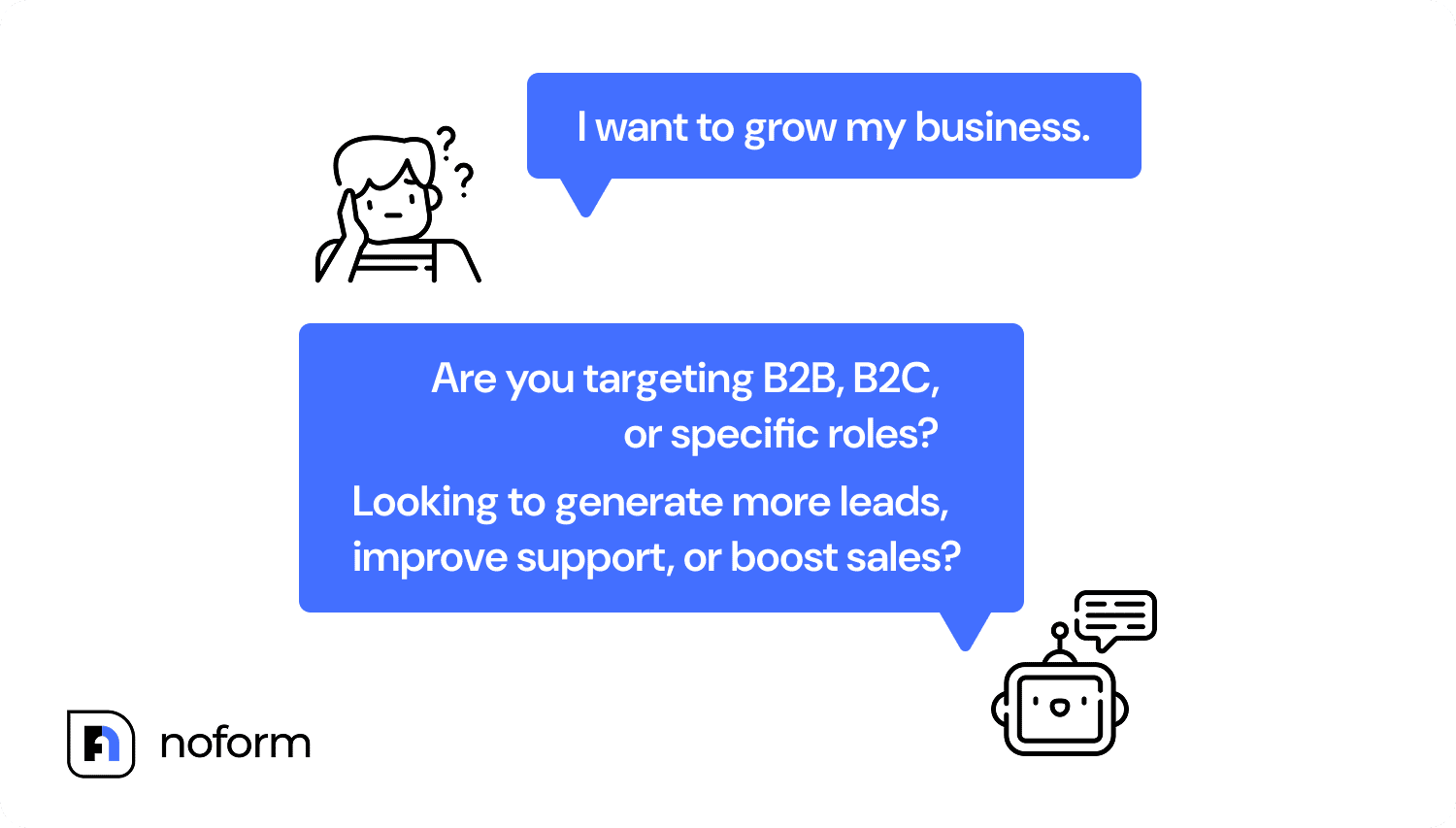
For example, if your goal is to reduce support volume by automating common questions, your chatbot testing should focus on teaching the bot to handle repetitive, common inquiries that don’t require a human. Simulate a user asking a simple question (“What’s my order status?” or “Do you offer refunds?”) and evaluate whether the chatbot provides accurate responses without deferring to the support team.
With NoForm AI, users can leverage built-in lead-gen chatbot features that allow training the chatbot to collect relevant information, qualify the lead, and track results within the dashboard.
Keep your training data fresh
Chatbot evolution depends on learning from real user behavior. Without regular updates, bots may become outdated and fail to provide accurate and relevant responses as new situations start arising, or your offerings change.
You can use NoForm AI’s analytics to identify misunderstood queries and update the training data accordingly. The platform allows you to review past conversations where the chatbot struggled or misunderstood user queries, helping identify factual errors and other issues.
Then, you can update the chatbot’s training to improve response accuracy based on user feedback and query history, resolving issues before they can become bigger.
Simulate real-world user interactions
Testing in perfect conditions doesn’t properly reflect real-world user interactions, which means you may get a false impression that your chatbot is working properly. People often input complex questions, use slang, or express emotion in unexpected ways, all of which can confuse the chatbot and cause it to produce incorrect or misaligned answers.
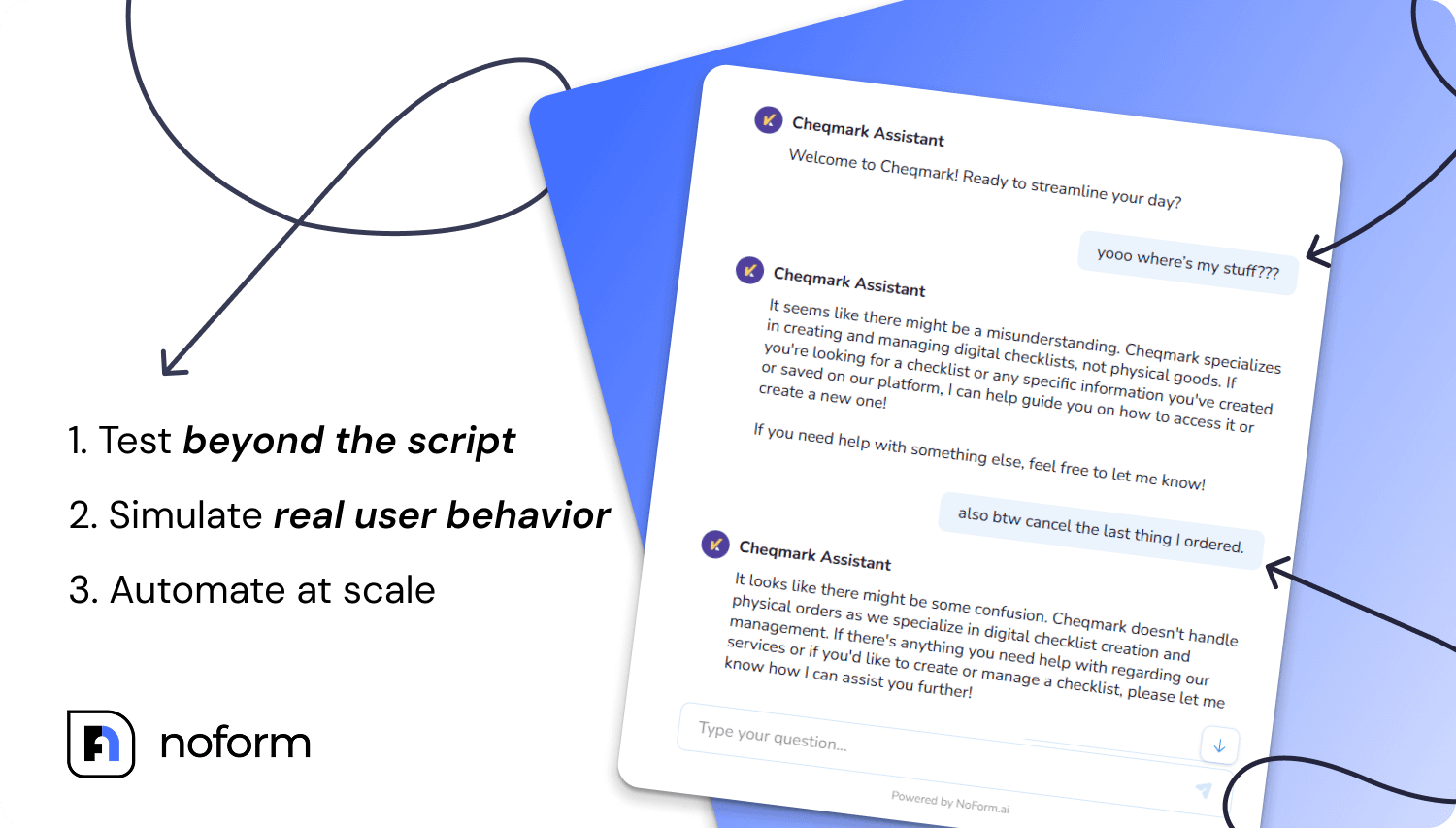
To avoid this, mix structured instructions with unexpected input, multitasking behaviors, or informal phrasing. Combine manual testing and chatbot testing automation to cover different test scenarios.
When you use NoForm, you get unlimited testing that allows you to run as many scenarios as necessary, increasing the likelihood that your chatbot performs well in real-world situations.
Test across different devices and platforms
Even if your chatbot runs well on your WordPress website, you need to ensure it performs well across various environments where users may engage with it. This includes different devices, browsers, and operating systems.
This step matters because different devices can interpret the code and layouts in various ways. So, while your chatbot may work flawlessly on desktop, it may run into some issues on a mobile device or even on a different browser. The best approach is to create a comprehensive device combination testing plan, using real devices you have available in addition to emulators to find hidden bugs.
Monitor and adjust
Even if your website chatbot works flawlessly initially, you can’t trust it won’t suffer from degradation in performance over time. To avoid this, you will need to continually monitor for any changes, getting ahead of issues before they start having a more significant effect on performance.
For example, if a growing number of user interactions end with unresolved queries, that’s a clear signal that you need to come back and retrain the chatbot, looking for new resolution paths that would work better.
With the help of NoForm’s built-in chat summaries, analytics, and insights, you can spot these trends faster and resolve them.

Maintain brand tone and alignment
A chatbot on a website cannot exist as a separate entity from your brand. The best chatbots should be a seamless extension of your brand tone and personality, even when handling frustrated customers or executing crucial tasks, such as capturing leads for your business.
For example, a chatbot for a financial startup should use clear, professional language, since customers want reassurance that the details about their financial matters are private and secure. Meanwhile, an eCommerce fashion brand may have a much more playful tone.
In the end, it comes down to matching user expectations and user preferences, giving your chatbot a more personalized and authentic feel that’s aligned with your overall brand experience.
Launch your chatbot faster with NoForm AI
An effective AI chat bot testing process helps ensure you’re not leaving your customers frustrated and are providing them with the most relevant and accurate responses in every situation. Whether it’s accurate sentiment analysis, handling common queries, or performance under pressure, thorough testing leads to a variety of benefits for businesses over time, helping drive business growth and deliver a positive user experience.
If you want a faster and easier way to launch and automate chatbot testing, NoForm AI enables you to build a chatbot in minutes using natural language processing and smart training features. Our platform allows you to simulate user input, track performance, and ensure your chatbots provide consistent, helpful answers—without relying heavily on human intervention. It also supports continuous testing to ensure high-quality interactions, helping to identify areas for improvement.
NoForm AI’s intuitive tools support every step of your AI chatbot testing workflow, ensuring your chatbots provide value from day one.
Start your 7-day free trial and see for yourself today!

